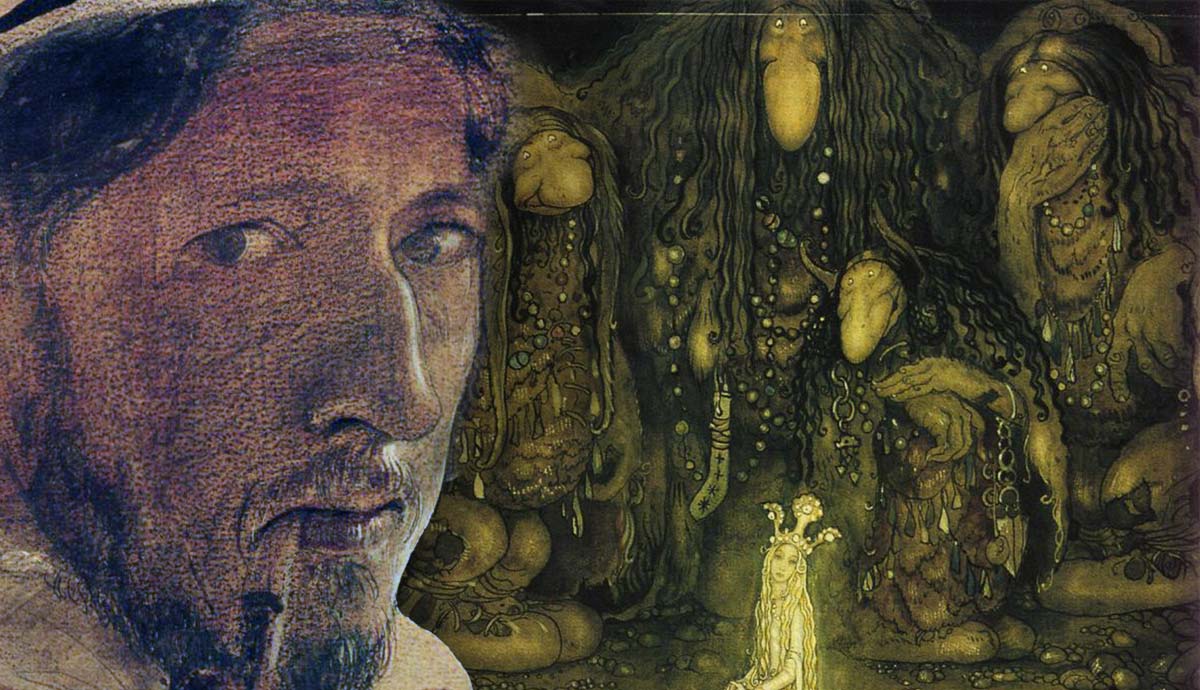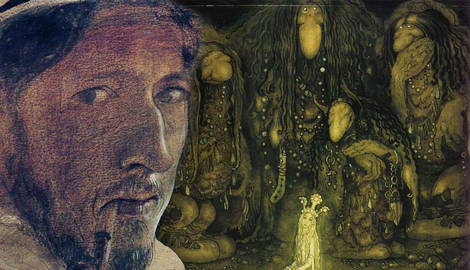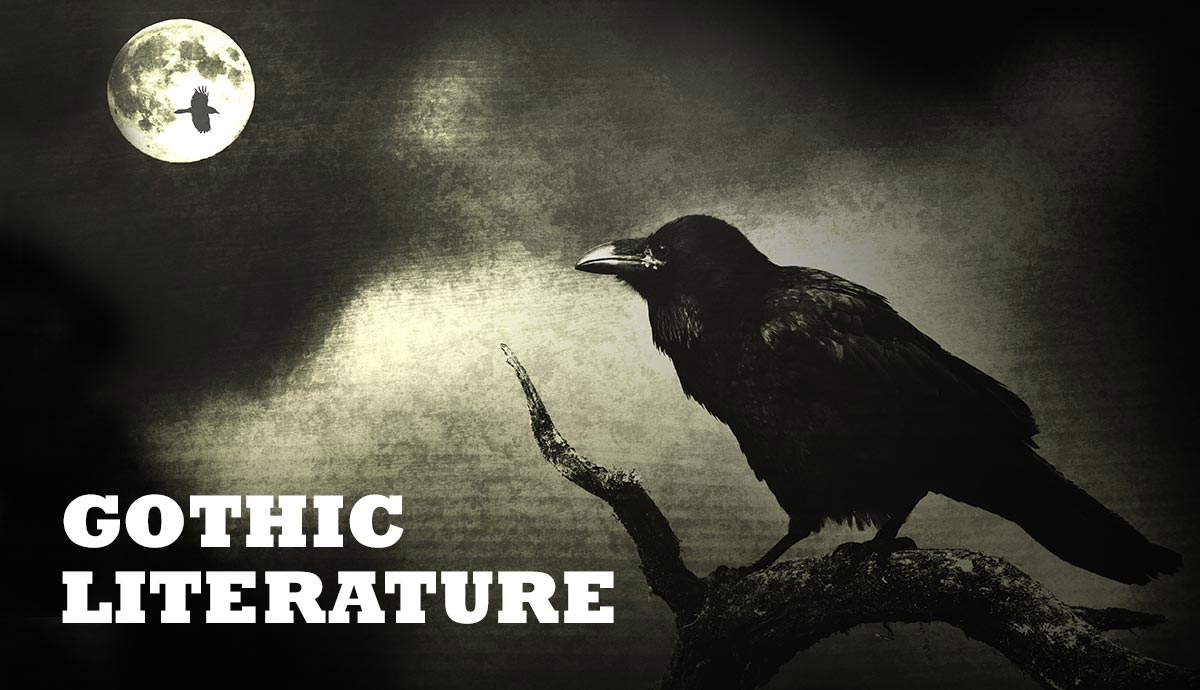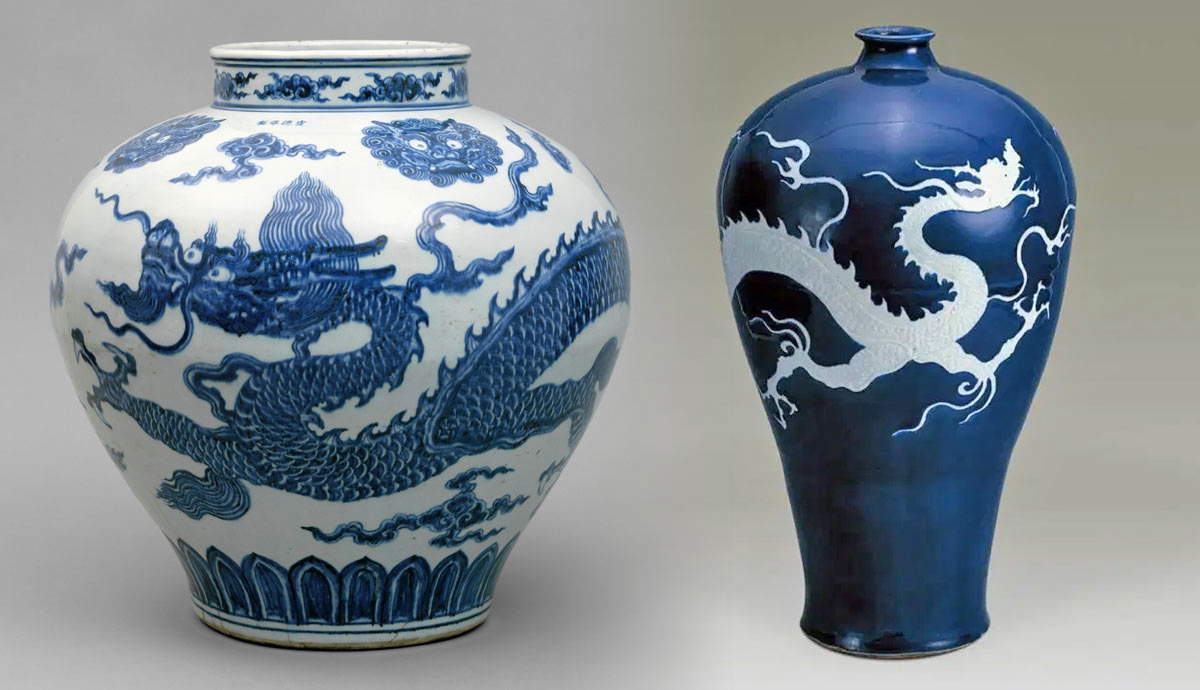
John Bauer was a Swedish artist, though born in Germany in 1882. When he was thirteen years old, his father’s charcuterie business became successful in Sweden, prompting the Bauer family to move their home to Jönköping County. Here, Bauer would grow up in an apartment above his father’s shop. However, due to the business’s success, the family was able to purchase a summer home called Villa Sjövik on the shore of Lake Rocksjön. This location would eventually become the family’s permanent home and would prove extremely influential for Bauer.
John Bauer’s Beginnings

The young John Bauer had a creative soul and healthy imagination, which was often reflected in his school grades. Surviving examples of his schoolwork as a child show that more effort was put into doodling in the margins than the actual schoolwork, much to his caricatured teachers’ dismay. When Bauer was sixteen years old, he left Jönköping to attend the Royal Academy of Liberal Arts in Stockholm. There is no record of his family’s reaction to this choice, though they offered him financial support, indicating they must have been at least somewhat supportive of his choice to study art.
He would stay in Stockholm for two years before being accepted into the school, though the time spent waiting was not wasted. He was hired to create illustrations for magazines and newspapers, which allowed him extra experience in the field, especially concerning illustrations for published material. Bauer’s original style was mostly eclectic as he sought to find his own style of artmaking, with joke drawings as typical. Throughout his time at the Royal Academy of Liberal Arts, his personal artistic style developed, and images of nature and its creatures began to appear in his works.
Ester Ellqvist

During Bauer’s attendance at the Royal Academy for Liberal Arts in Stockholm, he met his future wife, Ester Ellqvist. Their relationship began as a friendship, fostered in the environment they shared at the academy. Both were studying to be artists. When their relationship developed into a romantic connection, people took notice. They were said to be madly in love, with John being described as tender in his manner towards her. Many of his artworks include luminous women with long, curly blonde hair, all heavily inspired by Ester, and often modeled after her directly.
John Bauer and Ester Ellqvist married in 1906, resulting in Ester giving up her dreams of being a career artist to be a wife and mother. This would have been what was expected of her despite her education and personal career goals. The arts were considered a proper career for women to dabble in before they found a family to dedicate themselves to. Once they were married, they were expected to forgo their artistic pursuits to settle down, have children, and care for their family’s home. Almost immediately after marrying, they took a trip to Italy that would last two years.

Despite their deep love, they quickly realized after their wedding that they were not well-suited for each other. John found solace in nature, while Ester found the lake lonely. Her contemporaries described her as vivacious, so it is no wonder that she missed her friends, family, and the other social aspects of the city. The couple was often apart and corresponded through a series of letters, which survive to this day.
Despite their incompatibility, they seemed to be genuinely fond of each other. However, it is clear that John placed a large amount of pressure on his wife. He stated in a letter, “I have set you so high, Ester. And up there I want you. I feel sad when I see weak—if also human—traits in you.” Bauer saw a life that he wanted with Ester, as a career artist with a doting wife, no matter how she felt about it. Upon returning to Sweden two years after marrying, the couple purchased a home called Villa Björkudden on the shore of Lake Bunn, near Gränna. Within a year, in 1915, their son, Putte, was born.
A Traveling Artist

To complement his studies and work experience, Bauer traveled to various European regions to explore and hone his artistic skills and style. Traveling to hone artistic skills was common, a practice going back to the Middle Ages, to help budding artists become more worldly in techniques and subjects. During his school years, he traveled to Germany with his father, while later, with his wife, he went to Italy.
Bauer’s career was affected by the cultural changes occurring from the 18th century to the early 20th century. Europe was at the tail end of a social movement called Cultural Romanticism, which was meant to revitalize unique aspects of culture and restore individual cultural identities in Europe, especially concerning education, philosophy, science, and the arts. The movement was widespread, as it sought to end French supremacy across Europe. French culture was considered the epitome of sophistication in the 18th century during the Enlightenment, with the continent looking to France for the latest fashions, literature, and more.
This French supremacy prompted complaints from those who wished to see their own language and culture become important again in their country of origin. The goal was to distinguish the separate cultures of Europe, rather than continuing to shift into one massive European culture. In many ways, it was largely successful. Cultural dress began to reappear, such as traditional dress like bunader in Norway or kroje in Bohemia.

The Greeks formed a cultural identity, allowing them to rally to take back their land from the occupying Ottomans. Shakespeare was rediscovered in England, giving the English population literature to be proud of, rather than continuously looking to France for enlightenment. This cultural movement (which would have had over a hundred years of steam by the early 20th century), along with Bauer’s natural home environment of the Swedish forest, could be one reason why Bauer began to depict the Swedish landscape and fairy tales in his artwork, due to the changing art market to fit these new cultural values.
Bauer was insecure about his artwork in the beginning. He wanted to create oil paintings, but to do so, he needed money. Illustrations allowed him to make the money he needed to create more art. Therefore, Cultural Romanticism certainly had an impact on Bauer’s artwork, though it seems to have been indirectly from the cultural influences of the movement in literature and how it affected the art market, affording Bauer a way to make money rather than being personally invested in the idea.
As pride in Swedish culture grew, so did the demand for cultural arts, such as books about Swedish fairy tales that needed illustrations. Though Cultural Romanticism helped to revitalize aspects of culture in its beginning, it unfortunately also led to the development of xenophobia and right-wing political groups after World War I. Many of these groups still exist today and often support ethnic nationalism and problematic anti-immigration laws. The same cultural movement that allowed John Bauer to find work in Sweden creating illustrations for Swedish fairy tale books would later be weaponized by the Nazis, who used the idea to justify ethnic cleansing in the 1930s-40s.
Illustrating Fairy Tales

Bauer’s most celebrated work is, without a doubt, the illustrations from volumes 1-4 and 6-9 of Among Gnomes and Trolls. Among Gnomes and Trolls is an annual publication of Swedish fairytales and folklore, which continues to be published to this day. In volume 13 of Among Gnomes and Trolls, Tuvstarr (“cotton grass” in English) is a princess who lives in a dream castle. She wanders into the Swedish forest, where she meets a friendly moose named Skutt, who warns her of the dangers of the forest.
Despite the warning, Tuvstarr enters the dark forest only to have her clothing and crown stolen by elves and fairies. The only item she has left is the golden, heart-shaped locket that her mother gifted to her. As they pass a body of water, Skutt (“hop” in English) warns her not to look into the dark reflection. She disregards the advice and leans too far over the water, losing her precious locket to the depths. Heartbroken by the loss of her locket, she remains on the shore, forever searching as she slowly turns into cotton grass. To modern viewers, the illustrations of dark waters and eternal heartbreak are almost a dark foreshadowing for the family’s eventual demise.
In Princess Tuvstarr Gazing Down into the Dark Waters of the Forest Tarn, Tuvstarr is holding her hair out of the way to peer into the dark water below for her lost locket. She is naked, as the fairy has stolen her clothing from her. She has sat there for some time already, with her body positioned as straight as a plant’s stalk, cotton grass sprouting around her, and her beloved moose missing from the background.
The Shipwreck: John Bauer’s Death

Ester and John’s marriage was still deteriorating. The couple’s relationship was cracking under the pressure of their settled life. Despite their once-close friendship and willingness to make their marriage work, in 1918, they both finally agreed that a divorce was the best option for themselves and their son. Ester even wrote that they would all be much happier with an official divorce. Perhaps, in an attempt to maintain his marriage status, Bauer decided to move his family to Stockholm. Ester missed the city dearly, and the family packed up their belongings to take a ship to Stockholm, which would be their new home. However, they would never move to Stockholm or get a divorce, due to a horrific shipwreck that would take the lives of the entire family in November of that same year.
Their friends, Elna and Bengt Hedberg, were with them on the last night of their lives. Elna wrote about it in a letter to John’s parents, telling them about their son’s last day in the world. The weather was beautiful that evening, and the Bauers had come to visit them to say goodbye before their move to Stockholm. They had brought little Putte along with them, and he was playing and jumping. She recounts all of them laying on the carpet of their home and playing steamboats with the little boy, and him squealing with laughter at the game.

As the wind picked up outside, Bauer began to seem nervous, so he went to the harbor to ask the captain if all of the lifeboats and flotation devices were prepared for the journey. While there, he noticed that the ship was laden with sewing machines, ovens, and barrels of fruit puree that were also to be shipped while they journeyed. The captain, Theodore Boija, had stuffed the ship full of cargo to get as much money from the trip as possible. Elna remembers Ester being nervous about this, claiming she became quiet before their departure.
Elna and Bengt said goodbye to their friends and settled in for the night. The next day, they heard the news. As a storm rolled in, a wave slapped the side of the ship. The barrels of fruit puree had not been properly secured, causing the ship to tip over and sink. All 24 people on board were trapped in the ship as it filled with water. The bodies of the deceased were recovered by divers, with John’s body being found in the stairwell outside of the cabin and Ester inside the cabin’s living room, sitting with Putte on her lap. The wreck was not salvaged until 1922, four years after the incident.
The raising of the wreck was filmed on newsreels and drew a crowd of 20,000 people. Newspapers had played up the incident, claiming that Bauer had finally been taken by the folklore creatures he painted. It became a sensation, and in order to raise the funds to fix the ship, it was sent on a tour of Sweden so that more people could see the legendary ship—almost as legendary as those who went down with it.










